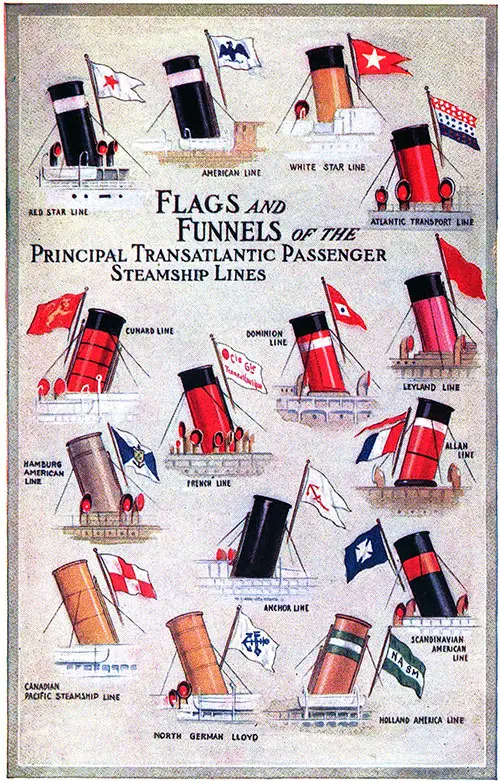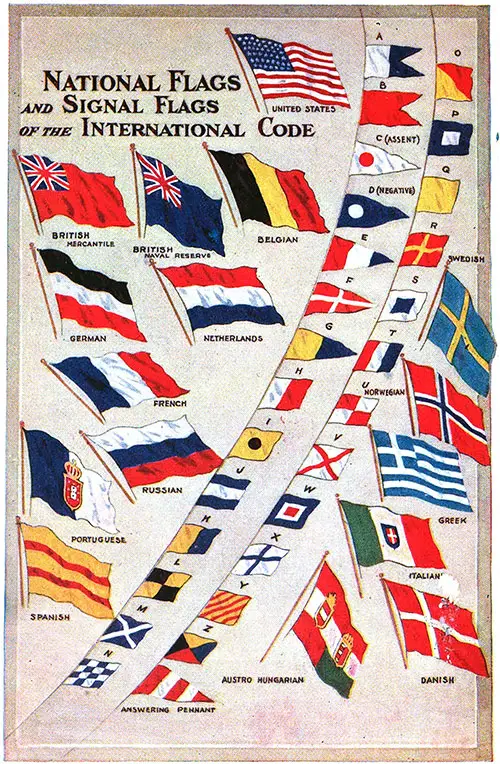Across the Atlantic in 1910: A Preface to Practical Ocean Travel
📌 Explore the candid, insightful 1910 preface to a transatlantic travel guide—offering practical advice, criticism of steamship lines, and predictions for the future of global travel. Ideal for teachers, students, genealogists, and maritime historians.

Hamburg-American Building, Child's Restaurant, and Flower and Company Bankers at Broadway and Exchange Place, New York in 1910. | GGA Image ID # 22877f9b67
🚢 Review and Summary: “Preface to the 1910 Travel Guide”
🌍 A Glimpse Into Early 20th Century Ocean Travel Preparedness
✨ Introduction: A Resourceful Companion for Ocean Voyagers
The Preface to the 1910 Travel Guide stands out as an engaging, forward-thinking introduction to a practical book designed to ease the complexities of transatlantic travel in the early 20th century. 🌊
From ticketing to timing, amusement to arrival, this guide was written not only to instruct but to empower travelers—whether they were seasoned voyagers or first-time immigrants navigating the ocean for a new life. Its tone is warm, candid, and rooted in personal experience, making it especially relevant for:
👨🏫 Teachers – Teaching about globalization, migration, and early tourism
📚 Students – Writing essays or understanding primary sources
👨👩👦 Genealogists – Contextualizing ancestral sea journeys
📜 Historians – Interpreting transportation and travel culture
There are no conditions of travel in which a few general hints as to how to adjust oneself to surroundings can prove so useful as on a sea voyage. It is with the object of preparing the traveler for his trip by telling him how to go, how much it will cost, how to amuse himself, and what to do on arrival at the coveted shore that this book has been written.
The writer believes that by providing just the sort of information that he and others of his acquaintance have wanted to know on various trans-Atlantic voyages, he can meet the needs of the average voyager fairly closely.
The writer also hopes that the information in this volume will be augmented in subsequent editions by its readers' voluntary experience. This addition cannot fail to greatly increase the book's value.
It may interest the reader to know that hundreds of pamphlets issued by various transportation companies throughout the world were thrown into the air, which produced this slender volume. This fact will give the reader some idea of the difficulties in editing a work of this character.
Within the last two or three years, steamship and railway companies have done much to eradicate space; it is now possible to make a complete earth circuit in 38 days, or less than one-half the proverbial 80 days of Jules Verne. The trip from London to San Francisco took less than ten days.

Flags and Funnels of the Principal Transatlantic PassengerSteamship Lines. (Facts for Travelers, 1908) | GGA Image ID # 17897db24c
It is possible to leave New York on Wednesday morning and reach London on Monday night to connect with trains that land passengers in Paris very early on Tuesday morning. All of this represents substantial progress in transportation. All of these matters are referred to in the appropriate sections of this book.
It is too early to prophesy what may be done in aerial passenger transportation, but given the various schemes proposed and almost carried out, it is possible that the next five years will see important developments along this line.
The Editor disclaims any responsibility for changes in times or rates. These are published in good faith for what they are worth, and the traveler is requested to write freely to the Editor regarding any statements that his experience may have shown to be inaccurate.
The Editor's gratitude is due to Mr. E. Justice of the North German Lloyd Steamship Company for much painstaking care and a careful reading of the proof and to Mr. L. Weickum of the Hamburg-American Steamship Company for much help of the same character and to both gentlemen for the use of superb collections of steamship pictures numbering thousands.
Remarkable photographs have been freely used without reference to whether the names of lines were mentioned, the sole effort being to show what a " Safer Sea" we navigate in. The present volume would appear dry without this aid. Mr. David Lindsay of the International Mercantile Marine Company has also furnished photographs, valuable tables, traveler's vocabulary, etc.
Beyond this, the steamship companies have been apathetic, showing a lack of appreciation for publicity, which is most extraordinary to the trained newspaperman. One company never even replied to repeated and courteous letters requesting information. Nevertheless, all have been treated impartially.

National Flags and Signal Flags of the International Code. | GGA Image ID # 178991f072
The American Express Company, The International Sleeping Car Company, and Thomas Cook & Son have also cooperated, and the Editor can commend their reliable services.
No advertisements of any description are permitted in this edition to avoid any suspicion of influence for editorial mention. Names are only mentioned in the text in the interest of the traveler. The references to specific lines or boats have been rendered as colorless as truth would permit.
To Mr. A. R. Bond of the Editorial Staff of the SCIENTIFIC AMERICAN, the writer is indebted for the valuable "Time" article and for preparing the article on the " Ocean, Navigation, Etc."
Much useful information has been abstracted from the Encyclopedia Americana, for which our thanks are due. For revision of sections of the work, thanks are also tendered to three or four score officials who have donated their work under the impersonal company's signature.
The writer is also indebted to Miss Julia E. Elliott for valuable assistance in collating and editing and to Mr. N. L. Stebbins for views of lightships, lighthouses, etc. References to books are credited in the text, particularly to the valuable book by Howden.
For words and music of national anthems, the miter is indebted to Charles H. Ditson & Co. and the Macmillan Co.; for statistical matter, to the New York World and the Brooklyn Eagle Almanac.
In closing, the hope is expressed that this little book will make some of the hours of the trip more interesting and that the information concerning Europe will prove of value, particularly as regards economical travel.
The section relating to London is written by a trained correspondent of the SCIENTIFIC AMERICAN, who is fully competent in treating his subject. The writer can testify to a recent visit to that city. The notes on Paris and Berlin are the results of recent visits to these capitals, supplemented, in Paris's case, by the notes of our Paris correspondent.
🧭 Key Relevance to Ocean Travel History
This preface reflects a turning point in global travel—when steamships had erased boundaries of space and time:
⏱️ Earth circuit in 38 days – Nearly half the time of Jules Verne’s imagined 80 days!
🌍 London to San Francisco in 10 days – A logistical feat!
⛴️ New York to London to Paris in under 6 days – Emphasizing speed and connectivity
The author not only records these marvels but hints at the dawn of air travel, anticipating its growth—making this preface a prophetic document in transportation history. 🛩️
Moreover, the guide is practical—it offers price comparisons, navigational tips, and vocabulary aids for those heading to Europe. It advocates fair editorial treatment of shipping lines while criticizing companies that failed to respond—a bold move for the time.
🖼️ Noteworthy Images
Several visual features enhance the article’s impact:
🚩 Flags and Funnels of Major Steamship Lines | 📸 GGA Image ID #17897db24c
A visual primer to help travelers identify liners by national and corporate symbols.
🚢 National and Signal Flags of the International Code | 📸 GGA Image ID #178991f072
It helps understand maritime communication during voyages.
🏛️ Hamburg-American Building, 1910 | 📸 GGA Image ID #22877f9b67
The image provides a helpful visualization of a steamship agency where one would purchase a ticket for passage abroad.
These images are not just decorative—they're functional historical tools for understanding maritime iconography, valuable in any classroom or research setting.
📚 Why This Resource Engages Educators and Historians
🧭 Contextualizes Travel Culture – Offers rare insight into the mindset of early 20th-century voyagers.
🧾 Primary Source Utility – Useful for showing how travel advice evolved and how publishers handled bias, data accuracy, and international cooperation.
⚓ Technological Awareness – The writer mentions the Marconi system, the speed of modern liners, and even envisions future air travel.
📖 Unfiltered Critique of Steamship Companies – The editor’s disappointment in uncooperative lines adds depth, showing tensions between journalism and corporate publicity.
🧳 Final Thoughts – Why This Preface Still Matters
This preface, written at the height of the ocean liner era, captures a moment when human mobility was redefining geography. It reflects both the optimism of modern travel and the frustrations of organizing it. The author’s emphasis on shared experience and honest reporting makes it a rare blend of guidebook, editorial, and social commentary.
📝 Students researching the rise of steamship travel, European migration, or the pre-WWI global tourism boom should turn to the GG Archives collection—and this volume—for invaluable insights.
📚 Use the GG Archives for Primary Source Gold
Encourage your students and researchers to cite this guide when writing essays on historical travel, global movement, or maritime culture. The Archives’ collection continues to be a port of call for the curious mind. ⚓✍️
